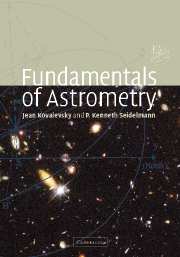Book contents
- Frontmatter
- Contents
- Preface
- List of abbreviations
- 1 Introduction
- 2 New observational techniques
- 3 Basic principles and coordinate systems
- 4 Treatment of astronomical data
- 5 Principles of relativity
- 6 Apparent displacements of celestial objects
- 7 Extragalactic reference frame
- 8 Dynamical reference frame
- 9 Terrestrial coordinate systems
- 10 Earth orientation
- 11 Stars
- 12 Double and multiple star systems
- 13 Astronomical phenomena
- 14 Applications to observations
- Appendix A Examples
- Appendix B Astronomical values
- Glossary
- References
- Index
13 - Astronomical phenomena
Published online by Cambridge University Press: 05 November 2011
- Frontmatter
- Contents
- Preface
- List of abbreviations
- 1 Introduction
- 2 New observational techniques
- 3 Basic principles and coordinate systems
- 4 Treatment of astronomical data
- 5 Principles of relativity
- 6 Apparent displacements of celestial objects
- 7 Extragalactic reference frame
- 8 Dynamical reference frame
- 9 Terrestrial coordinate systems
- 10 Earth orientation
- 11 Stars
- 12 Double and multiple star systems
- 13 Astronomical phenomena
- 14 Applications to observations
- Appendix A Examples
- Appendix B Astronomical values
- Glossary
- References
- Index
Summary
Motions involved
The combinations of different motions of Solar System bodies, involving orbital motions with their respective eccentricities and inclinations, as well as rotations with different planes and periods, lead to a variety of phenomena.
These range from the obvious, such as the rising and setting of the Moon and planets, seasons on the Earth, and the phases of the Moon, to the less-obvious phases of the planets and apparent stationary and retrograde motions of the planets. The ellipticities and inclinations of the orbital motions of the bodies also lead to some variations of these phenomena.
The motions of the Earth, Moon, planets, and satellites lead to objects obscuring other objects and the sunlight onto those objects. The lack of visibility due to the proximity to the Sun, the visibility due to elongation from the Sun, or the positioning opposite to the Sun, are also resulting phenomena.
The motion of the Earth in its orbit determines the seasons and, with the Moon's motion, is the basis for the different calendars. The seasons are defined from the times of equinoxes and solstices. While the equinox may not be used for the reference frame anymore, it will continue to be the basis of defining the seasons, and can be determined from the Solar System ephemerides being used. Likewise, the times of perihelion and aphelion for the Earth and all the planets are determined from the ephemerides.
- Type
- Chapter
- Information
- Fundamentals of Astrometry , pp. 307 - 322Publisher: Cambridge University PressPrint publication year: 2004



